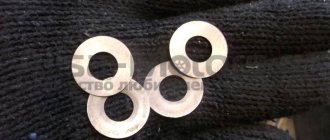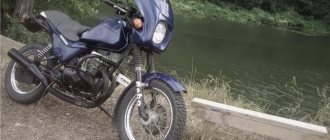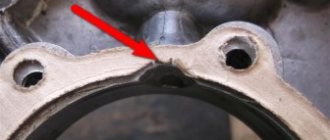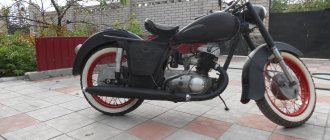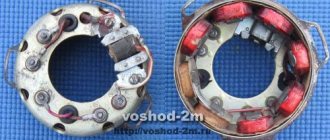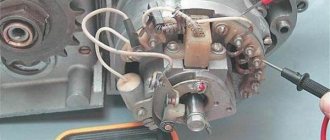So, before assembling the engine, we thoroughly wash all the parts, check the condition of the crankcase and threaded connections, clean and blow through two oil channels (marked with an arrow) located in the upper part of the crank chamber, prepare a clean work area, take two planks and place the left half of the crankcase on them.
Using a special puller, install the crankshaft oil seal retaining ring into the left half of the crankcase.
From the inside of the crank chamber, we install a spacer ring into the mounting hole of the main bearing.
We heat the mounting hole of the main bearing with a technical hair dryer and, using a mandrel, install the oil seal all the way and immediately, so that later you do not forget to lubricate the edges of the oil seal with clean engine oil.
Place the oil guide washer on the oil seal; the washer has a convex shape similar to a plate; when installing, orient its convex side towards the oil seal.
We again heat the crankcase mounting hole with a hairdryer and, using a mandrel, install the outer race of the crankshaft main bearing into it. In the second half of the crankcase, the main bearing race is installed exactly according to the same principle.
It is worth cautioning: many people who are unfamiliar with technology prefer to press the main bearings onto the crankshaft in the classic collective farm way: they take a hammer or sledgehammer and simply, with all their heart and soul, brazenly hammer the bearing into place.
Thoroughly lubricate the lip of the oil seal and the race of the main bearing with clean engine oil, then very carefully, so as not to accidentally wrap the cuff on the oil seal, twist the crankshaft a little into the left half of the crankcase. Depending on the situation, we either hammer or knock out the crankcase guide bushings (marked with arrows) so that they extend 5-6 millimeters above the crankcase connector plane.
We degrease the crankcase planes of both halves of the crankcase, apply a layer of engine sealant to one of them, lubricate the main bearing and the oil seal edge of the second half of the crankcase well with oil, and tap the crankcase halves a little with a wooden mallet.
Immediately put the gearbox cover in its place without the gasket and tighten the crankcase bolts. The bolts should be tightened according to this principle: we start tightening the crankcase with the bolts located in its middle and then tighten the remaining bolts crosswise, gradually increasing the force over several circles and tighten them completely.
We turn the engine over, heat the seat with a hair dryer and, using a mandrel, install the crankshaft support bearing in its place, then install the retaining ring there.
Many people unknowingly cover this channel with sealant, which naturally leads to the destruction of the oil seal and the main bearing (an example of the destruction of the main bearing is shown at the end of the article). The standard gasket does its job perfectly, so there is absolutely no need to apply sealant to this place.[/stextbox]
Unfortunately, it will not be possible to display all the stages of assembling this engine in one article, primarily for technical reasons. Therefore, the repair of other components of this engine will be described in the following articles, and as they are added, links will be provided in this article. And that's all for today.
Provide a list of bearings and oil seals for Izh motorcycles, indicate their installation locations and dimensions
To begin with, let's agree that all bearings and seals will have the same size designations: the first number is the outer diameter, the second is the inner diameter, and the third is the height (or width).
And now - the list itself: bearing 104 - outer clutch drum and input shaft: 42X20X12; bearing 203 - engine crankcase and intermediate shaft, wheel bearings: 40X17X12; bearing 204 - engine crankcase and input shaft: 47X20X14; bearing 205 - crank chamber covers, engine crankcase and crankshaft axle shafts, rear wheel sprocket: 52X25X15; bearing 2505KM - engine crankcase and crankshaft axle shaft of the Izh-P4 engine: 52X25X18; bearing 192906K1 - engine crankcase and secondary shaft: 46.4X30X13; bearing 778706 - steering column: 48X30X12; right crankshaft oil seal “Izh-49” 1—48—3: 30Х16.5Х10.5; secondary shaft oil seal “Izh-49” 1—47—2: 52 X 34.5 X 9; left crankshaft oil seal "Izh-Yu" Sat. 1—49: 52.2X24.4X10; crankshaft oil seal (for “Izh-Yu4”) “Izh-Yu” coll. 1—15—1: 52.2×24.4X6; wheel seal "Izh-56" coll. 4—29: 36.5X21.5X6.5; front fork oil seal "Izh-P" sb. 3—10—1: 43X32X8.5; left oil seal (for “Izh-P4”) “Izh-49” coll. 1—49: 52X24.4X20; cuff Izh-P2-222: 84X58.5X8; rear shock absorber oil seal “Izh-56” 2—99—1: 24Х9.2Х X12.7; sealing ring for gear shift shaft “Izh-P2” 1—421: 17.7X13.7X2; secondary shaft nut cap “Izh-P2” 1—416: 43.5X4.5X14.5; trigger shaft oil seal (for Izh-Yu4) “Izh-Yu2” 1—132—1: 32X23X14; sealing ring for the trigger shaft “Izh-P2” 1—423—1: 28.4X22X6. 58. List the bearings used on the Voskhod-3 motorcycle and indicate their number and sizes.
Crankshaft bearings 205, 3 pcs., 47X20X14; input shaft bearing 203, 1 piece, 40 X 17 X 12; steering column bearing 746905, 2 pcs., 44X26X21; needle bearing of the lower head of the connecting rod 464805D, 1 pc., 31X25X18.5; gearbox intermediate shaft bearings 202, 2 pcs., 35 X 15 X 11; wheel bearings 60204, 4 pcs., 47X20X14; secondary shaft bearing roller, 42 pcs., 4X6; clutch release rod and central switch ball, 3 pcs., 4.763; kickstarter pedal ball, 1 pc., 6.35; rear wheel sprocket bearing 60304, 1 pc., 52X20X15.
Source
Crankshaft bearings Izh Planet (2505KM 2 pieces metal cage)
Characteristics of bearing 2505 / N2205
| Parameter | Designation | Meaning | Units |
| Bearing inner diameter | d | 25 | mm |
| Bearing outer diameter | D | 52 | mm |
| Bearing width | IN | 18 | mm |
Please note, these are new bearings. They are declared to be manufactured in Russia, although in fact it is impossible to verify the manufacturer of the components, since often modern Russian factories are only assembly sites.
Table of oil seals IZH Jupiter 5
Reader A. Ustinov from Kemerovo asks what bearings and seals are used on the IZH-Planet and IZH-Jupiter motorcycles, and asks for their numbers.
The crankshaft of the Planet motorcycle (all models) rests on two 2505K roller bearings and one 304 ball bearing (on the left). Its trunnions are sealed with an oil seal designated IZH-49 sb. 1-30-1 with cover (right) and seal IZH-49 sb. 1-40-3 (left).
The Jupiter crankshaft (also of all models) is mounted on three 205 ball bearings and on 304 ball bearings (on the left). The oil seals are as follows: right - IZH-49 sb 1-30-3 with a cover, left - IZH-Yu sb. 1-50 and one oil seal IZH-Yu sb. 1-14-1 in each of the two crank chamber covers.
The secondary shaft of the gearbox for both Planeta and Jupiter is supported by roller bearing 192906 K1M and sealed with an IZH-49 sb oil seal. 1-28-1.
The primary shaft of all motorcycles on the left rests on a 204 ball bearing, and on the right - on a bronze bushing inside the secondary shaft
The outer clutch drum of the IZH Jupiter and Planet-3 motorcycles rotates in bearing 104, and the shaft of the starting mechanism (kick starter) is sealed in the left crankcase cover with an IZH-Yu2 sb oil seal. 1-52 (only for “Jupiters”).
For all these motorcycles, the front fork in the steering column of the frame is supported by two thrust ball bearings 778706.
The wheel bearings of all these same motorcycles (two per wheel) are ball bearings 203 (or 60203), and the rear wheel sprocket bearing is ball bearings - 205. To protect wheel bearings from dust, simple felt seals were used until 1965, and then special rubber seals were used - IZH-56 Sat 4-27.
The axis of the pendulum fork is sealed with two felt seals IZH-56. 2-90 and two rubber ones with a spring - IZH-56 sb. 2-99.
The front fork stays also have two oil seals each: felt - IZH-49. 3-23 and rubber - IZH-P sb. 3-7
Removing the rear wheel
Let's move on to removing the rear wheel. We remove the seat by pressing the lever, which is located in the front part of the base of the seat, open it and see that there are wires connected to it, connected on chips, which go to the brake light mounted in the pencil case, located at the back. We disconnect them, and, pulling the seat back, remove the seat along with the frame wing.
Removing the seat from an IZH motorcycle
Now nothing bothers us. We proceed to loosen the drum, tension bolts with lugs, which are located on both sides of the wheel and are tightened with a bolt (axle), then carefully knock out the axle itself and take it out, after which we screw the nut back onto the bolt and put it in a clean box or cloth. We also put a spacer sleeve there. Do not forget that the threads are left-handed everywhere, that is, they unscrew clockwise.
The process of dismantling the axle of an IZH motorcycle
We remove the wheel by lifting it up and, slowly rocking it, moving it left and right out of the drum. The drum can be left on the suspension if it does not require any intervention.
Removing the rear wheel
Five random motorcycles:
Five random articles about motorcycles:
CZ 988 Touring motorcycle
Cross CZ – Chezet 980, 981, 984
Chezet 980, 981, 984 Soviet riders are well familiar with the Chezet-980 motorcycles, which are in service with many sports clubs. The Czechoslovakian production program, along with road motorcycles of the 125 and 175 cm3 classes, also includes sports motorcycles intended for cross-country racing. These machines are the most widely known. Many racers from the Soviet Union, East Germany, Poland, Austria, Belgium, the USA and other countries compete at them. To meet the demand of the export market, the company had to sharply increase the production of motocross cars. If in 1970 2,000 of them came out of the factory in Strakonice, then in 1971 there were already 5,000. This year it is planned to produce more than 8,000 cross-country “chesets” of different models. Today the company produces machines of three international classes: 125, 250 and 500 cm3. These models have “980” and “981” respectively. They are all quite similar in design, and two .
Motorcycle IZH Jupiter 4
Jupiter of the fourth generation The team of the Izhmash production association completed the tenth five-year plan with a double labor victory: a new mechanical assembly building was put into operation, where the production of IZH-Jupiter-4 motorcycles was mastered. “Jupiter-4” is distinguished by a successful combination of the best solutions, tested both on its previous models, as well as on Planet-Sport. The ENGINE has undergone further modernization. Thanks to improved filling and changes in the design of the purge channels, its maximum power has been increased from 25 to 28 hp. s., and torque - from 3.23 to 3.58 kgf.m. In this regard, an additional pair of discs was introduced into the CLUTCH. The FRAME is also interchangeable with previous Jupiter models. The changes affected only the mounting of the gas tank, where rubber shock absorbers were used to reduce vibrations. The shape of the tank has become more modern, and the factory emblem also looks new. IN THE CHASSIS thanks to the modernization of the front.
Testing the Ural IMZ-8.103-10 motorcycle
The new familiar Ural It just so happened that despite all the popularity of the heavy motorcycles of the Irbit plant, not one of them has yet come to us for editorial testing. Meanwhile, readers have repeatedly persistently recommended that we get to know them better. And last spring we finally received a new Ural. However, first there was a trip to the plant. It was January. But when one of us got off the train, I was amazed to see about a dozen motorcycles on the station square. The frost is about 30 degrees, the wind is windy - and people ride motorcycles as if nothing had happened! In Moscow, and in other large cities in the European part of the country, you won’t see this in winter. After three days in Irbit, the motorcycle became familiar on the streets and became familiar to the eye. The Irbit motorcycle plant, which grew out of nowhere during the war years from an evacuated Moscow enterprise, now seems to be quite a large company, with a capacity that allows it to produce up to 130 thousand cars a year. However, the equipment
Foreign analogues of bearings
Foreign analogues of bearings
Post by forsage1994 » Mar 10, 2011 6:19 pm
I would like to find analogues of Russian bearings and seals used in IZH. Let's start with a list of those. descriptions))
Bearings ball, radial, single row. 104 Outer clutch drum and input shaft - 1 piece (20, 42, 12) - analogue 6004 60203 Wheel hub - 4 pieces (17, 40, 12) - analogue 6203 (Features - 2RSH - contact rubber seal on one side (Maybe better with two ?), perfectly retains lubricant inside) 203 Engine crankcase, intermediate shaft - 2 pcs (17, 40, 12) - analogue 6203 60303 Cast wheel hub - 2 pcs (17, 47, 14) - analogue 6203(2RSH) 204 Engine crankcase, primary shaft - 1 piece (20, 47, 14) - analogue 6204 6-205 or 205 Crank chamber cover, engine crankcase, crankshaft axle shafts, rear wheel sprocket - 4 pieces (25, 52, 15) - analogue 6205(C3) 6-304 K or 304 Engine crankcase, left crankshaft axle shaft - 1 piece (20, 52, 15) - analogue 6304(C3)
192906 Radial roller bearing. Engine crankcase, secondary shaft - 1 piece (30, 46.4, 13) - no analogues)) 778706 Angular contact ball bearing. Steering column - 2 pieces (30, 48, 12) - no analogues))
IZH 49 Sat. 1-29-1 Right crankshaft oil seal - 1 piece (30, 15.5, 7.5) IZH 49 sb. 1-28-1 Secondary shaft oil seal - 1 piece (52, 34.5, 9) IZH P2 1-421 Gear shift shaft sealing ring - 1 piece (17.7, 13.7, 2) IZH P2 1-416 Secondary shaft nut cap - 1 piece (43.5, 2) 4.5, 14.5) IZH Yu sb. 1-50 Left crankshaft oil seal - 2 pcs (52, 24.4, 10) IZH 56 sb. 4-28 Oil seal for front, rear wheels and trigger shaft - 3 pcs (36.5, 21.5, 6.5) IZH P sb. 3-10-1 Telescopic fork oil seal - 4 pcs (43.4, 32, 8.5) IZH 56 2-99-1 Rear wheel suspension shock absorber oil seal - 2 pcs (24, 9.2, 12.7) IZH PZ 10-7-1 Suspension reservoir oil seal rear wheel - 4 pieces (31, 24, 3.5) IZH.Yu5 sb. 1-61 Trigger shaft cuff - 1 piece (35, 21.4, 7) IZH Yu sb. 1-14-1 Crankshaft oil seal - 2 pieces (52, 24.3, 6)
I’m thinking of selecting manufacturers’ representatives from 3 categories - Cheap, Average and Expensive. If you get everything in order, you can use it as an article)
Source
Installing wheel bearings
Pressing the bearings is done in the reverse order, but there are some nuances here. You need to act more responsibly, since performance and durability will depend on how correctly you do everything.
Press in the first bearing. To do this, place the old unnecessary bearing on top of it and carefully hit it with a hammer (as in the figure below) On the back side of the wheel, insert a spacer sleeve. The process of pressing in new bearings
Once the bearings are in place, we move on to the final process.
Delivery to any region of the Russian Federation
We deliver to the regions:
- Russian Post (cash on delivery, payment upon receipt of the parcel)
- TK PEK / TK Business Lines (with prepayment of order)
Parcels are sent daily. Currently, Russian Post provides prompt delivery of parcels to any region of the Russian Federation. Delivery time to most major cities is 1-7 days. Please check with your manager or on the Russian Post website for the exact delivery time to your location. It is possible to send the order outside the Russian Federation.
Courier delivery (Moscow and Moscow Region)
- delivery cost by courier service in Moscow is 320 rubles
(within the Moscow Ring Road) - delivery cost outside the Moscow Ring Road is 55 rubles
in addition to the basic tariff for every 5 km - delivery of orders with a total weight of more than 10 kg
- calculated individually by the manager - Urgent delivery within the Moscow Ring Road up to 10 kg 500 rubles
, delivery is carried out within 3-4 hours.
Payment for courier delivery occurs upon delivery of the order.
Crankshaft bearings Izh Planet (2505KM 2 pieces metal cage)
Characteristics of bearing 2505 / N2205
| Parameter | Designation | Meaning | Units |
| Bearing inner diameter | d | 25 | mm |
| Bearing outer diameter | D | 52 | mm |
| Bearing width | IN | 18 | mm |
Please note, these are new bearings. They are declared to be manufactured in Russia, although in fact it is impossible to verify the manufacturer of the components, since often modern Russian factories are only assembly sites.
Needle bearing IZH Jupiter 5
Guys, the question is, who on Jupiter 5 installed a needle bearing in the piston themselves, how to choose the diameter of the needles.
A needle bearing in the piston or in the upper end of the connecting rod. If it is in the upper head of the connecting rod, then they are already sold ready-made on the market; you insert them instead of bushings. And another question: who installed such bearings, how does the engine start to work? and whether it will crumble over time.
In 1961, an Izhevsk motorcycle called Jupiter was released. A new family of IZH Jupiter has appeared. The design is similar to the IZH-56 motorcycle produced earlier. Its significant difference is the installation of a two-cylinder engine. In addition, some changes have been made to the clutch, gear shift device and electrical equipment.
Installation of the cylinder-piston group
It is not advisable to remove the gearbox cover until the sealant has dried; there is no need to rush in this matter. It’s better not to rush things and install the cylinder while the sealant dries.
Add some motor oil:
To improve lubrication, it is advisable to drill holes in the piston bosses. But you don’t have to drill - it depends on your desire.
Install the piston pin retaining ring into the boss. Before installation, it is advisable to bend the locking ring a little and be sure to check how it fits after installation:
We heat the piston with a hairdryer and, using a mandrel, drive the finger into the piston so that it comes out no more than 5-6mm.
We look for an arrow-shaped mark on the bottom of the piston.
We orient the piston with the arrow towards the exhaust port of the cylinder (“towards the exhaust”), put the piston on the connecting rod, hammer in the piston pin and install the second retaining ring.
We insert the rings into the cylinder and measure the gap between the locks with a feeler gauge:
To improve the wearability of the rings and reduce noise from engine operation, it is advisable to chamfer the edges of the rings. If hunting gets too much trouble: place the ring on a flat surface and use a file to slightly round the edges.
We put the rings on the piston, fill the piston with the rings with oil, install a gasket under the cylinder (preferably with sealant), tighten the rings with a clamp. We cut the clamp out of tin and from the same tin we bend the bracket with which we will fix it.
Izhevsk Fork: myths and reality
Many say that this miracle has been dead since birth, and there are even myths and legends about those who saw IZH with a fully working plug)))
I didn’t take pictures of the process of restoring and tuning the fork, honestly I didn’t have time for that. I’ll describe the process in detail, and I’m only attaching photos of the final result (some changes are clearly visible in them). I thought I’d get it done faster. Yeah, right now. The reanimation of the fork ate up all three of my weekends.
I had three forks available. Different years, different condition. Looking ahead, I will say that even with three forks there were not enough spare parts.
Day 1. I started by gutting the forks. Two were with straight stays, and two were with bent support pipes. The disassembly was fun) One of the forks was obviously filled with salidol instead of oil (well, the consistency is accurate), the others clearly suffered from a lack of oil. After disassembling all the forks, I realized that none of them were assembled correctly. On one there were no lower guide bushings at all, on the other the shock absorber cups were bent (don’t ask, I’m tormented by guesses myself).
I chose more or less living supporting pipes (for restoration), sliding pipes, springs, shock absorbers, and washed all this first in gasoline, then in solvent. It was necessary to make new lower guide bushings and cups (which are textolite in stock). I selected blanks for them according to size, drew up drawings and took them to the turner. The bushings were sharpened from ShKh13 (for those not familiar with metal, bearing steel), and the cups were made from special blue polyurethane (a relative of polyurethane, not very distant).
Assembling the crankcase halves
We degrease the connector of the halves, knock out the guide bushings a little so that they extend 5-6 mm above the plane. Depending on your desire, we assemble the checkpoint. Personally, I assemble the gearbox only after assembling the engine, it’s more convenient for me.
We apply any automotive sealant to the connector, install the second half of the crankcase, tap it with a mallet, install the gearbox cover and tighten the crankcase with bolts.
We do not pull the bolts anyhow, but strictly according to Feng Shui: we pull about a third of the force, first the middle crosswise, then the periphery, and gradually increasing the force over several circles, we tighten the bolts as much as is sufficient.
Engine IZH Jupiter
In 1961, an Izhevsk motorcycle called Jupiter was released. A new family of IZH Jupiter has appeared. The design is similar to the IZH-56 motorcycle produced earlier. Its significant difference is the installation of a two-cylinder engine. In addition, some changes have been made to the clutch, gear shift device and electrical equipment. At the front of the crankcase there are two crank chambers, and at the rear there is a gearbox. The crank chambers are closed with covers and each of them contains crankshafts on ball bearings, which are protected from axial displacement by retaining rings. The crankshaft axle shafts are sealed with oil seals. Under the left crankcase cover mounted on a gasket, the front chain drive, clutch and trigger mechanism are located. The crankshafts are connected to each other by an external flywheel. The generator rotor and the breaker cam are installed on the axle cone of the right crankshaft. The generator housing is mounted on the crankcase. The engine pistons are connected to the crankshaft connecting rods using piston pins, which are protected from axial displacement by retaining rings. The engine cylinders have aluminum jackets and cast iron liners. The cylinder heads are made of aluminum alloy and are attached together with the cylinders to the crankcase with studs.
Engine part of IZH Jupiter
The motor part of the engine consists of a cylinder-piston group, a crank mechanism and a crankcase group.
Motor part of IZH Jupiter: 1 – generator cover; 2 – right crankcase cover; 3 – generator; 4 – right seal with cover; 5 – right crankshaft; 6 – right half of the crankcase; 7 – flywheel; 8 – crankshaft seal; 9 – crank chamber cover; 10 – left crankshaft; 11 – left seal; 12 – left half of the crankcase; 13 – crankshaft sprocket; 14 – left crankcase cover; 15 – cylinder; 16 – cylinder head; 17 – piston; 18 – spark plug; 19 – connecting rod; 20 – hairpin.
Engine parts IZH Jupiter
Engine parts: 1 – cylinder pipe; 2 – cylinder gasket; 3 – left cylinder; 4 – hairpin; 5 – left cylinder head; 6, 12 – washers; 7 – nuts; 8 – retaining ring; 9 – piston; 10 – piston ring; 11 – left cheek of the crankshaft; 13 – connecting rod; 14 – right cheek of the crankshaft; 15 – flywheel; 16 – bushing; 17 – piston pin; 18 – crankshaft; 33 – flywheel mounting bolt; 34 – crank pin; 35 – needle bearing.
Clutch IZ Jupiter
Located on the left side of the engine in an oil bath. Closed with a lid with a gasket to prevent oil leakage. The main thing that can be said when assembling the coupling. Some conditions need to be met. The first compression spring nuts should protrude 3.5 - 4.0 mm above the caps. This will save the disks from distortion. Tighten the second adjusting screw until it stops. Then loosen by 1/4. 1/2 turn. Essentially this is a clutch adjustment.
Details of the Izh Jupiter clutch: 19 – bracket with lever; 20 – outer clutch drum; 21 – pusher; 22 – ball; 23 – thrust rod; 24 – inner clutch drum; 25 – clutch drive disk; 26 – driven disk; 27 – pressure disk; 28 — cap; 29 – spring; 30 – shaped nut; 31 – adjusting screw; 32 – nut.
Preparation for repair
When starting work, initially prepare the place where you will disassemble your pet. Wash the area where you will park the motorcycle thoroughly so that unnecessary objects and dirt do not interfere with your further actions. You also need to wash the motorcycle before disassembling, although many do not want to do this, but for your own convenience and the comfort of removing vehicle spare parts, this must be done.
To disassemble a motorcycle, you need to prepare the necessary tools, without which it is impossible to replace the bearings.
Tools that will be required to work with the Soviet motorcycle IZH:
You will also need lubricating oil. You can use regular diesel oil to lubricate bolts and during assembly; solid oil or litol-24 - for impregnation of a new bearing. Decarbonizing WD-40 (or a similar penetrating lubricant) may be useful to remove rust from bolts that are difficult to remove.
Telescopic fork - removal, disassembly, assembly and installation, replacement of shock absorber fluid
The telescopic fork has to be removed and disassembled when there are knocking noises during movement, deterioration of vibration damping, leaks, as well as a planned replacement of shock absorber fluid. 1. Remove the front wheel with the brake drum cover.
2. Disconnect the front wheel mud shield from the left sliding pipe of the fork.
loosen the nut of the steering column upper cross member.
Unscrew the shock absorber plug a few turns.
loosen the tightening of the nut of the coupling bolt of the lower bridge (traverse).
6. Using light blows of a hammer through a wooden spacer, knock out the supporting pipe from the upper and lower traverses.
7. Remove the fork leg from the lower crossbar.
Similarly, remove the second fork leg.
Install the plug in reverse order.
1. Remove the fork leg from the motorcycle (see above).
2. Turn out the shock absorber plug completely.
3. Turning the fork blade over, drain the shock-absorbing fluid.
4. Clamp the pen in a vice by the lower tip, using an 11 mm
Using an extension, unscrew the bolt securing the hydraulic shock absorber.
5. Take out the shock absorber along with the spring.
6. Using a special ring or “gas” wrench, unscrew the oil seal housing.
7. Remove the sliding pipe from the supporting pipe.
8. Clamp the shock absorber in a vice through the gasket at the lower tip.
unscrew the nut and locknut of the rod, having previously remembered (written down) the size of the protruding threaded part of the rod.
10. Remove the nuts, washer and spring.
12 mm spanner
unscrew the rod tip.
12. Remove the rod assembly from the shock absorber strut.
13. We wash all parts of the removed shock absorber in kerosene or white spirit.
Reinstalling the wheel
The consequences of this operation determine how many times you will twist the nuts. As a rule, everyone is in a hurry to tighten the brake drum - this is not worth doing.
So, first of all, of course, we put our wheel into the drum, then we need to get the bolt into all the necessary holes and tighten it with a nut. Now we proceed to tensioning the chain with special tension bolts. It should not be overtightened, but it should not be loosened either, as it will quickly stretch and may eventually fall off while moving. After making sure that the chain is tensioned correctly and the wheel is level (see suspensions accordingly), proceed to tighten the drum, then tighten the wheel. Well, the very last moment - put the seat on, not forgetting to connect the wiring, and remove the motorcycle from the stand.
This completes your repair. In all this, do not forget to monitor the tension of the spokes and do not allow the tire to be flat.
Replacing motorcycle wheel bearings 5 (100%) 4 votes
Electrical equipment of the IZH Jupiter motorcycle
The electrical equipment of the IZH Jupiter motorcycle differs only in the installation of the G-36M2 generator.
Electrical diagram of the IZH Jupiter motorcycle:
1 — rear light; 2 — neutral lamp switch; 3 - central switch; 4 — neutral indicator lamp; 5 — speedometer lighting lamps; 6 - main lamp; 7 — parking light lamp; 8 — light switch; 9 — sound signal; 10 — brake light switch; 11 - candle; 12 — control lamp; 13 - fuse; 14 - battery; 15 — relay-regulator; 16 - generator; 17 - capacitor; 18 - breaker; 19 - ignition coil.
Provide a list of bearings and oil seals for Izh motorcycles, indicate their installation locations and dimensions
To begin with, let's agree that all bearings and seals will have the same size designations: the first number is the outer diameter, the second is the inner diameter, and the third is the height (or width). And now - the list itself: bearing 104 - outer clutch drum and input shaft: 42X20X12; bearing 203 - engine crankcase and intermediate shaft, wheel bearings: 40X17X12; bearing 204 - engine crankcase and input shaft: 47X20X14; bearing 205 - crank chamber covers, engine crankcase and crankshaft axle shafts, rear wheel sprocket: 52X25X15; bearing 2505KM - engine crankcase and crankshaft axle shaft of the Izh-P4 engine: 52X25X18; bearing 192906K1 - engine crankcase and secondary shaft: 46.4X30X13; bearing 778706 - steering column: 48X30X12; right crankshaft oil seal “Izh-49” 1—48—3: 30Х16.5Х10.5; secondary shaft oil seal “Izh-49” 1—47—2: 52 X 34.5 X 9; left crankshaft oil seal "Izh-Yu" Sat. 1—49: 52.2X24.4X10; crankshaft oil seal (for “Izh-Yu4”) “Izh-Yu” coll. 1—15—1: 52.2×24.4X6; wheel seal "Izh-56" coll. 4—29: 36.5X21.5X6.5; front fork oil seal "Izh-P" sb. 3—10—1: 43X32X8.5; left oil seal (for “Izh-P4”) “Izh-49” coll. 1—49: 52X24.4X20; cuff Izh-P2-222: 84X58.5X8; rear shock absorber oil seal “Izh-56” 2—99—1: 24Х9.2Х X12.7; sealing ring for gear shift shaft “Izh-P2” 1—421: 17.7X13.7X2; secondary shaft nut cap “Izh-P2” 1—416: 43.5X4.5X14.5; trigger shaft oil seal (for Izh-Yu4) “Izh-Yu2” 1—132—1: 32X23X14; sealing ring for the trigger shaft “Izh-P2” 1—423—1: 28.4X22X6.
58. List the bearings used on the Voskhod-3 motorcycle and indicate their number and sizes.
Crankshaft bearings 205, 3 pcs., 47X20X14; input shaft bearing 203, 1 piece, 40 X 17 X 12; steering column bearing 746905, 2 pcs., 44X26X21; needle bearing of the lower head of the connecting rod 464805D, 1 pc., 31X25X18.5; gearbox intermediate shaft bearings 202, 2 pcs., 35 X 15 X 11; wheel bearings 60204, 4 pcs., 47X20X14; secondary shaft bearing roller, 42 pcs., 4X6; clutch release rod and central switch ball, 3 pcs., 4.763; kickstarter pedal ball, 1 pc., 6.35; rear wheel sprocket bearing 60304, 1 pc., 52X20X15.
Source

